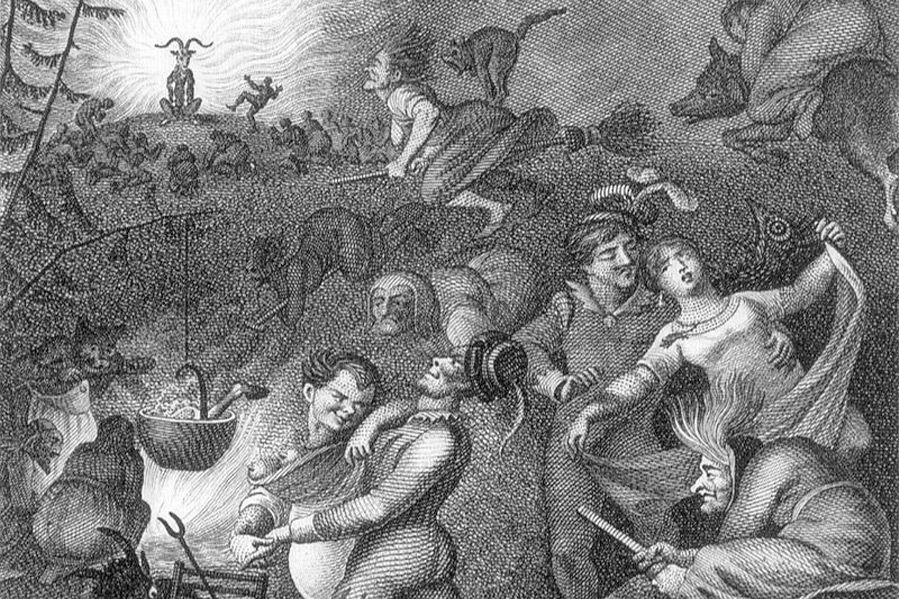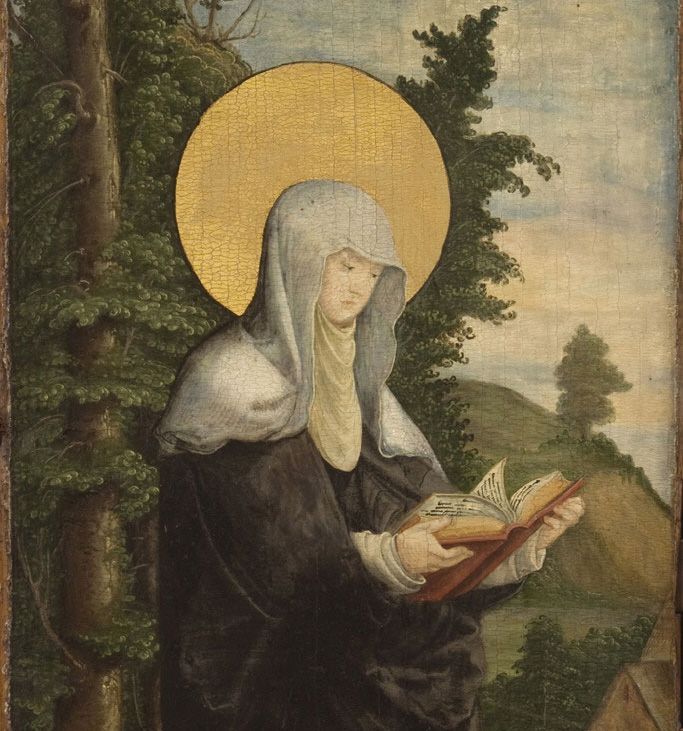
It goes by many names: Walpurgisnacht, Walpurgis Night, Saint Walpurga’s Eve, Night of Walpurgis… This Catholic feast day was once little known outside of central Europe, but has grown increasingly popular globally in recent years.
Celebrated on the night of April 30th and through May 1st, Walpurgisnacht has become an unofficial “Halloween 2” in Germany, where revelers dress in creepy costumes, light bonfires, and engage in all manner of drunken revelry.
But what is Walpurgis Night? How did the saintly canonization of an 8th century abbess become intertwined with traditional pagan festivals? And why is this holiday still celebrated today?
We'll seek to answer all of those questions.
Who Was Saint Walpurga?

Walpurgisnacht is named after Walpurga, a missionary sent from England to Christianize the pagans of central Europe in the 8th century.
The daughter of Richard the Pilgrim, Walpurga spent decades studying for this mission; She was made the abbess of Wimborne Abbey in Dorset at the age of 11, where she was educated as a nun. Walpurga was the niece of Boniface, a Benedictine monk who recruited her and her brothers in his mission to Christianize the pagan Germans around 748.
Walpurga quickly proved an invaluable asset to the mission, becoming a nun at the double monastery of Heidenheim am Hahnenkamm, which was established by her brother Willibald. Following his death, she was appointed both abbess and superintendent of the double monastery, giving her authority over both men and women – a rarity in that time.
Walpurga was known both for her tireless fight against dangerous diseases common at the time, like “pest, rabies, and whooping cough,” as well as for her crusade against pagan magic, sorcery, and witchcraft, working to stamp out such heathenism (as she saw it) with the word of her Christian god.
Walpurga died in either 777 or 779. She was buried at Heidenheim, and was canonized as a Catholic saint by Pope Adrian II a century later, on May 1st, 870.
The Origins of Walpurgisnacht
Following her death, Walpurga was highly regarded, both by Church officials and laypeople – but also by many of the pagans she helped convert to Christianity.
Though her feast day is February 25th, the date of her canonization, May 1st, became the prime time to celebrate her life, and bonfires were lit in her honor.
Given her popularity as a saint, medicine woman, and church leader, Walpurgis Night quickly became one of the most popular celebrations in Europe.
The overlap of this date with May Day, a pre-Christian pagan festival celebrating the changing season, may be coincidental. However, the timing was certainly convenient...
Stop us if you’ve heard this next part before: for the Christians, the overlapping festival dates proved an opportunity to try and co-opt a pagan holiday into a Christian celebration.
Walpurgisnacht celebrations have a lot in common with Beltane (also known as May Day). Some experts speculate that Walpurga's sainthood could have been purposely placed on May 1st in an attempt to subvert the pagan celebration of Spring, with the church adopting Beltane traditions in an attempt to win pagans over to the Christian holiday.
However insidious, this strategy proved useful for unconverted pagans, who used the overlapping celebrations as an opportunity to continue practicing their pagan traditions under the guise of conversion. If questioned on their activities, they could simply attest that they were celebrating Saint Walpurga.
Even today, some Walpurgis Night celebrations carry over into May Day activities.
The Night of the Walpurgis
But back to our story: all was well for centuries, until hysteria around witchcraft hit Europe. By the 16th century, pagan practices were no longer tolerated, and scores of “witches” were sentenced to death by church leaders, local law enforcement, and witch hunters.
The prevailing belief was that witches gathered on April 30th in secret at the misty peak of Mount Brocken, deep in the Hanz Mountains, to plot with Satan, commit human sacrifice, and engage in orgies.
Amidst the mass anti-witch hysteria, people across Europe lit bonfires on April 30th to protect themselves from this devilry – and yet again, the meaning of these late April, early May bonfires were changed.

Over time, the fear of witches subsided, but many in Europe still celebrate Walpurgisnacht as a fun and spooky holiday similar to Halloween, where revelers dance in costumes, drink beer, and cause some minor mayhem. And, yes, they still light bonfires.
Night of the Witches
Meanwhile, on the same night, a similar but separate holiday takes place: Hexennacht, or "Night of the Witches."
People who practice witchcraft, identify as witches, or feel solidarity with them gather to mark the occasion. For some, the holiday has solemn undertones, as it recalls the horrible persecution faced by those associated with witches and witchcraft in previous centuries.
The largest and most raucous Hexennacht celebrations fittingly take place in the foothills of the Brocken, where the witches were originally believed to gather. Revelers dress up as witches and dance around bonfires to commemorate their ancestors.
If you go, don’t forget your broomstick.
58 comments
-
Walpurgisnacht is celebrated by modern Satanists as "Hexennacht" ('Witches' Night'), to honor those who have fallen victim to superstition and ignorance, whether by witch hunt, Satanic panic, or other injustices.
-
All fundamentalist of religion are victims of superstition and ignorance. Your point is well taken.
-
Nothing to do with fundamentalism. Wirccraf is evil.
-
-
Doesn't sound creepy to me! What a way to tie into Beltane. But it is sad that some still fear pagan beliefs. Christian beliefs are also often odd, and steeped in pagan beleifs (smoke, chants, song, prayer, etc, to name just a few). We are all the same seeking our own way. Why does it have to be creepy just because someone else does it a different way?
-
That's Catholicism.
-
Yes. I am a "recovering Catholic." LOL! So many pagan elements are woven in, and yet the church tries to tell us everyone else is evil. Makes no sense to me. Oh well. I've found my path and am in a very good place.
-
Many paths, same destination.
-
Timothy C Stone, Nope! If you worship the devil, you're headed for hell. Sorry, reality check!
-
-
Feel what you are saying....went to Parochial grade school and literally had things beat into me......brother went to hs seminary and then on to college seminary, but got out....lived past the sexual abuse and is my crazy brother. I have grown out of religion and now a spiritualist.
Live and learn!! Rev Laurel
-
-
ServantOfJudgement,
That's Constatinian Churchianity :-)!
-
-
-
I think people are thinking of Beltane. The spring festival that celebrates renewed life. Bonfires are lit, and blessings are given. It's a wonderful holiday. People dance about the may-poles, and celebrate the coming of the summer months.
https://www.bpl.org/blogs/post/the-origins-and-practices-of-holidays-beltane-and-the-last-day-of-ridvan/
-
Actually, this is not uncommon practice. Voodoo (or Wodun) in African countries practiced by natives who were "Christianized" under missionary priests used the Saint to hide their own native gods. They worshipped what they wanted and the proud priests considered these nativeslives saved for Christ. Interesting situation. I did a paper in college on Syncretic Religions of the Caribbean Basin as a Form of Colonial Resistance, and filled it up when I was in seminary.
-
Patricia, thanks for your post. I'm sure you have read THE SERPENT AND THE RAINBOW by Wade Davis. Your college paper must be a great read. I had very similar interest in college, but my path was along Jung's mysticism.
-
-
Beltane! A festival of joy and renewal. Until another desert religion blazed a path of hatred, persecution, death and ignorance across the world. The Christians thought they'd destroyed the Pagan, but no, they failed utterly. We're still here! "Thou shalt not suffer a witch to live." Fascist doctrine of hate!
-
"Thou shalt not suffer a witch to live" was actually a bastardized revision made for the King James edition. The prior version was, "Thou shalt not suffer a POISONER to live." Blessed be Gary.
-
The KJV is a bastardized version of true scripture.
-
Timothy C Stone,
The KJV is the most reliable translation from the original texts!
-
-
-
-
My wife and I would fit right in......will most definitely have to attend sometime!
-
Saint Walpurga - that is the first time I ever heard the name or anything about this saint. Thank you for a very well written article. Interesting!
-
I initially thought Walpurgisnacht was one of those words Joe Biden created when attempting to read the teleprompter. 🤭
🦁❤️
-
At least our President would have known what this is all about, unlike some other person who flounders through so called speeches. Just saying, as it seems politics needed to be brought to this horse race.
-
In his head he might have known what it was all about. Getting everyone to understand what he’s saying is a totally different matter. (Pause) 🤭
Thank you for accepting my humor. (Period) 🤗
🦁❤️
-
-
Hahahaha!!! Could be right anyhow, I'm sure I've herd say it! Pause.
-
No you're thinking of The Tangerine Terrorist, who's on it's way to a prison cell. 😈
-
Maybe trump will get a cell next to Putin's political opponents.
-
He might get a cell next to Hunter Biden, but we all know that Hunter is a protected species, much like his dad, and Clinton, et al. 🤭
🦁❤️
-
-
Lionheart,
We did need your ironic input once again, Lionheart!
-
Thank you, Sir George. I try my best to add humour, mixed with reality, to this blog. 🤭
🦁❤️
-
-
-
Modern Satanists No Thanks
-
Satanism didn't even exist till 1966, you're obviously mistaking it with "devil worship".
-
Michael,
A Satanist posted:
"Walpurgisnacht is celebrated by modern Satanists as "Hexennacht" ('Witches' Night'), to honor those who have fallen victim to superstition and ignorance, whether by witch hunt, Satanic panic, or other injustices.
Please let the modern Satanist know he's wrong.
-
Rev. Michael Gerraghty II,
Satanism = Paganism!
-
-
-
I wish you all well. ...Blessed be.
-
She proves that all faiths belong together and are happily celebrated in their own traditions, but for the one common goal, getting together and enjoying each other's company and celebrations. In this story I could see her as multiple faiths in one, even though they give her one denomination, she appeared to be accepted in many. We must learn to accept and refuse to fight. That's a great story, thanks for sharing❣️
-
Jannetje Eleanore Van Went,
I find these articles indeed very informative!
-
Jannetje Eleanore Van Went,
I find these articles indeed very informative!
-
-
The more that we read, the more we learn about things that we didn't even know existed. Even if they are good or bad it's good to know about them. Thank all of you for your input..
-
Very interesting read, I had never known where the name "Walpurgisnacht" originated. Walpurga is such a lovely name, why doesn't anyone name their kids that anymore?
A very happy Beltane to all who celebrate, and Blessed Be!
-
Writer is a little biased calling another faiths holiday "creepy". What ever happened to the ULC saying We are all children of the same universe?
-
Saint Walpurga - who is that? This blog post made me do a quick search. It is interesting that pagan rituals celebrating the seasons had much to do with the successful rise of agriculture, and then were demonized and/or co-opted by later monotheistic religions, who also celebrated the changing seasons by absorbing pagan rituals into their own celebrations.
People are not canonized without a miracle or two attributed to them during their lifetime. One "miracle" attributed to Saint Walpurga was the instant calming of a storm at sea, in which she was a passenger on a boat. One wonders at this "miracle", and how it was adjudicated as such by 8th century investigators.
Couldn't the 'miraculous' calming of the storm simply be that the storm front had just passed over them, and the skies and seas were once again calm, and NOT St. Walpurga's kneeling in prayer on the deck? In the 700's, though, most people weren't aware of such things. Easy enough then to fool the minds of the masses you wish to convert.
All the hoopla and controversy around pagan vs religious beliefs has blinded us to how much has been hidden from us, in terms of an accurate historical record of events from that time. In my mind - it's a "Nontroversy". Party on, Pagans!
-
Dorothy Hawkins,
You are misinformed. Before a saint is canonized in the Roman Catholic Church (and I believe the same applies to Eastern, Oriental, and Uniate Orthodox Churches), the 'servant of God' must be attributed a miracle through their intercession by those who are promoting their sainthood cause before ad after beatification. So it isn't during their lifetime.
-
-
Blessed be y’all.
-
Seems as if there are more holidays than there are days in a year. Let all celebrate what and who they want. I celebrate many days, but I worship only one God, Creator of the universe.
-
Correction, four Greater Sabbats. And 13 esbats per solar year so 17 in total based on times of year. And the biblical pantheon is NOT monotheistic it clearly mentions several deities.
-
-
Dont know what this thread writer is talking about. this is called Valborgsmässoafton in Swedish, Vappu in Finnish, Volbriöö in Estonian, Valpurģu nakts or Valpurģi in Latvian or Hexennacht in German, it was NEVER called Walpurgisnacht except for it being a Christian Holiday that was taken from them. My mothers father was German and came to the US from Eppigen Germany all because he and his brothers didnt want to serve the Kaiser in his stupid wars. At NO time on April 30th was there any mention of witches or anything like that it was all celebrated in the local catholic church.
Wer solchen Blödsinn glaubt, ist zu dumm, um zu existieren
-
Daniel Gray,
Once again, you claim to know better!
-
Once again you get very upset when you are proved wrong with historical fact
-
-
-
Bonfire and folks standing around with a beer sounds like a weekend at my place.
I think people make up reasons to relax instead of just relaxing.
-
Daniel, es ist night nett heir Deutsch zu Schreiben. Oder verstehst du das nicht? Mõchtest du das andere Menchen sollten heir Spanisch schreiben?
-
Oops, Ich habe such Deutsch gescheibt. LOL. 😉
-
-
My favorite celebration –
-
I have heard of this, but have studied more about hexennacht, and it's hexen beast, this is one demon that I would never want to meet up with, these rituals are some of the worst and thought to be a merger with the devil himself, now it seems like its an excuse for an sexual orgy
-
Sounds like fun. Halloween is my favorite holiday. I have more Halloween decorations than we have for Christmas. There is nothing wrong with people coming together to have safe fun.
-
Timothy C Stone,
Are orgies a safe fun?
-
-
My son is an artist whose online company is: Pandora Art. He drew good witch images for a calendar for his sister a few years ago. He has developed them into lined journals and sketch books on Amazon. If you would like to take a look, log onto Amazon: books: A Witch Journal Pandora Art. Hope you LOVE them!
-
Great historical facts, thank you. I didn't even know this existed now or in the past


Nothing terribly controversial here, thus the lack of argumentative comments. Just the usual ancient pagan celebrations commandeered and rededicated by Christians. For instance, the winter solstice (yule) is the beginning of longer days, i.e. the return of the sun - or Son (his "birthday"), nicely co-opted, even though most scholars tend to date Christ's true birthday in March. More Christian shenanigans. I'm going to rename my birthday "The Advent of Special Me" in similar fashion.
Rev. BH,
I am a Messianic Jew. The birth of Jesus is pointed on Sukkot, between the end of September and October.